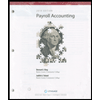
FINANCIAL AND MANAGERIAL ACCOUNTING
9th Edition
ISBN: 2818440048890
Author: Wild
Publisher: MCG CUSTOM
expand_more
expand_more
format_list_bulleted
Question
Chapter 3, Problem 18DQ
To determine
Introduction:
Financial statements: The financial statements of a company are prepared at the end of an accounting year to calculate the total liabilities, total assets, net profit or loss, and increase or decrease in cash during the year. The financial statements are used by various external and internal parties.
To prepare: The reversing entry of given accrued salary expenses. Also, state the time of preparing reversing entry.
Expert Solution & Answer
Want to see the full answer?
Check out a sample textbook solution
Students have asked these similar questions
I don't need ai answer general accounting question
What does the current ratio measure?a) Profitabilityb) Debt levelsc) Liquidityd) Efficiency
Help it
Solve with explanation and general accounting question
Chapter 3 Solutions
FINANCIAL AND MANAGERIAL ACCOUNTING
Ch. 3 - Prob. 1QSCh. 3 - Computing accrual and cash income C1 In its first...Ch. 3 - Identifying accounting adjustments P1 Classify the...Ch. 3 - Prob. 4QSCh. 3 - Prepaid (deferred) expenses adjustments P1 For...Ch. 3 - Prepaid (deferred) expense adjustments P1 For each...Ch. 3 - Prob. 7QSCh. 3 - Prob. 8QSCh. 3 - Prob. 9QSCh. 3 - Prob. 10QS
Ch. 3 - Prob. 11QSCh. 3 - Prob. 12QSCh. 3 - Prob. 13QSCh. 3 - Prob. 14QSCh. 3 - Prob. 15QSCh. 3 - Prob. 16QSCh. 3 - Prob. 17QSCh. 3 - Prob. 18QSCh. 3 - Prob. 19QSCh. 3 - Prob. 20QSCh. 3 - Prob. 21QSCh. 3 - Prob. 22QSCh. 3 - Prob. 23QSCh. 3 - Identifying post-closing accounts P5 Identify...Ch. 3 - identifying the accounting cycle C2 List the...Ch. 3 - Prob. 26QSCh. 3 - Prob. 27QSCh. 3 - Prob. 28QSCh. 3 - Prob. 29QSCh. 3 - Prob. 30QSCh. 3 - Prob. 31QSCh. 3 - Prob. 32QSCh. 3 - Prob. 33QSCh. 3 - Prob. 34QSCh. 3 - Prob. 35QSCh. 3 - Prob. 36QSCh. 3 - Prob. 37QSCh. 3 - Prob. 38QSCh. 3 - Prob. 39QSCh. 3 - Prob. 40QSCh. 3 - Prob. 1ECh. 3 - Prob. 2ECh. 3 - Prob. 3ECh. 3 - Prob. 4ECh. 3 - Prob. 5ECh. 3 - Prob. 6ECh. 3 - Prob. 7ECh. 3 - Prob. 8ECh. 3 - Prob. 9ECh. 3 - Prob. 10ECh. 3 - Prob. 11ECh. 3 - Prob. 12ECh. 3 - Prob. 13ECh. 3 - Prob. 14ECh. 3 - Prob. 15ECh. 3 - Prob. 16ECh. 3 - Prob. 17ECh. 3 - Prob. 18ECh. 3 - Prob. 19ECh. 3 - Prob. 20ECh. 3 - Prob. 21ECh. 3 - Prob. 22ECh. 3 - Prob. 23ECh. 3 - Prob. 24ECh. 3 - Prob. 25ECh. 3 - Prob. 26ECh. 3 - Prob. 27ECh. 3 - Prob. 28ECh. 3 - Prob. 29ECh. 3 - Prob. 30ECh. 3 - Prob. 31ECh. 3 - Prob. 32ECh. 3 - Prob. 33ECh. 3 - Prob. 34ECh. 3 - Prob. 35ECh. 3 - Prob. 36ECh. 3 - Prob. 37ECh. 3 - Prob. 1PSACh. 3 - Prob. 2PSACh. 3 - Prob. 3PSACh. 3 - Prob. 4PSACh. 3 - Prob. 5PSACh. 3 - Prob. 6PSACh. 3 - Prob. 7PSACh. 3 - Prob. 8PSACh. 3 - Prob. 9PSACh. 3 - Prob. 10PSACh. 3 - Prob. 11PSACh. 3 - Prob. 1PSBCh. 3 - Prob. 2PSBCh. 3 - Prob. 3PSBCh. 3 - Prob. 4PSBCh. 3 - Prob. 5PSBCh. 3 - Prob. 6PSBCh. 3 - Prob. 7PSBCh. 3 - Prob. 8PSBCh. 3 - Prob. 9PSBCh. 3 - Prob. 10PSBCh. 3 - Prob. 11PSBCh. 3 - No Account Title Debit Credit 101 Cash $38,264 106...Ch. 3 - Prob. 1GLPCh. 3 - Prob. 2GLPCh. 3 - Prob. 3GLPCh. 3 - Prob. 4GLPCh. 3 - Prob. 1.1AACh. 3 - Prob. 1.2AACh. 3 - Prob. 1.3AACh. 3 - Prob. 1.4AACh. 3 - Prob. 2.1AACh. 3 - Prob. 2.2AACh. 3 - Prob. 2.3AACh. 3 - Prob. 2.4AACh. 3 - Prob. 3.1AACh. 3 - Prob. 3.2AACh. 3 - What is the difference between the cash basis and...Ch. 3 - Why is the accrual basis of accounting generally...Ch. 3 - What type of business is most likely to select a...Ch. 3 - Prob. 4DQCh. 3 - Prob. 5DQCh. 3 - Prob. 6DQCh. 3 - Prob. 7DQCh. 3 - Prob. 8DQCh. 3 - Prob. 9DQCh. 3 - Prob. 10DQCh. 3 - Prob. 11DQCh. 3 - Prob. 12DQCh. 3 - Prob. 13DQCh. 3 - Prob. 14DQCh. 3 - Prob. 15DQCh. 3 - Prob. 16DQCh. 3 - Prob. 17DQCh. 3 - Prob. 18DQCh. 3 - Prob. 1BTNCh. 3 - Prob. 4BTN
Knowledge Booster
Similar questions
- What does the current ratio measure?a) Profitabilityb) Debt levelsc) Liquidityd) Efficiency explanation.arrow_forwardI am looking for the correct answer to this general accounting question with appropriate explanations.arrow_forward2. Which financial statement shows a company’s financial position at a specific point in time?a) Income Statementb) Statement of Cash Flowsc) Balance Sheetd) Statement of Retained Earningsarrow_forward
- Answer this Accounting Problemarrow_forwardAssume the actual sales volume is 74,500 units and the budgeted sales volume is 76,000 units. If the actual sales price is $7.20 and the budgeted sales price is $7.80, what is the sales volume variance? a) $11,700 unfavorable b) $11,700 favorable c) $10,500 unfavorable d) $10,500 favorablearrow_forwardGeneral accountingarrow_forward
arrow_back_ios
SEE MORE QUESTIONS
arrow_forward_ios
Recommended textbooks for you

 Intermediate Accounting: Reporting And AnalysisAccountingISBN:9781337788281Author:James M. Wahlen, Jefferson P. Jones, Donald PagachPublisher:Cengage Learning
Intermediate Accounting: Reporting And AnalysisAccountingISBN:9781337788281Author:James M. Wahlen, Jefferson P. Jones, Donald PagachPublisher:Cengage Learning- Century 21 Accounting Multicolumn JournalAccountingISBN:9781337679503Author:GilbertsonPublisher:Cengage
 College Accounting (Book Only): A Career ApproachAccountingISBN:9781305084087Author:Cathy J. ScottPublisher:Cengage Learning
College Accounting (Book Only): A Career ApproachAccountingISBN:9781305084087Author:Cathy J. ScottPublisher:Cengage Learning College Accounting (Book Only): A Career ApproachAccountingISBN:9781337280570Author:Scott, Cathy J.Publisher:South-Western College Pub
College Accounting (Book Only): A Career ApproachAccountingISBN:9781337280570Author:Scott, Cathy J.Publisher:South-Western College Pub


Intermediate Accounting: Reporting And Analysis
Accounting
ISBN:9781337788281
Author:James M. Wahlen, Jefferson P. Jones, Donald Pagach
Publisher:Cengage Learning


Century 21 Accounting Multicolumn Journal
Accounting
ISBN:9781337679503
Author:Gilbertson
Publisher:Cengage

College Accounting (Book Only): A Career Approach
Accounting
ISBN:9781305084087
Author:Cathy J. Scott
Publisher:Cengage Learning

College Accounting (Book Only): A Career Approach
Accounting
ISBN:9781337280570
Author:Scott, Cathy J.
Publisher:South-Western College Pub